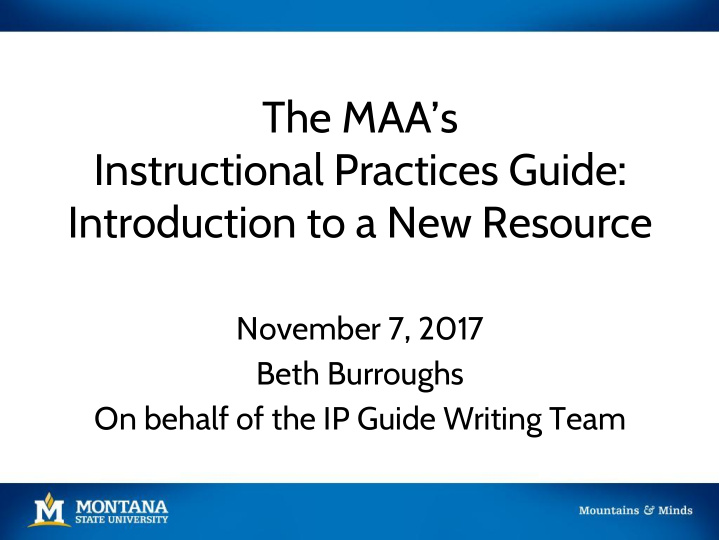



The MAA’s Instructional Practices Guide: Introduction to a New Resource November 7, 2017 Beth Burroughs On behalf of the IP Guide Writing Team
Leadership Team •Martha Abell, Georgia Southern University •Linda Braddy, Tarrant County College •Doug Ensley, Mathematical Association of America •Lew Ludwig, Denison University •Tensia Soto-Johnson, University of Northern Colorado Steering Committee (Lead Writers) •James Alvarez, University of Texas, Arlington •Ben Braun, University of Kentucky •Beth Burroughs, Montana State University •Rick Cleary, Babson College •Karen Keene, North Carolina State University •Gavin LaRose, University of Michigan •Julie Phelps, Valencia College •April Strom, Scottsdale Community College
Writers Scott Adamson Mike Pinter • • Claire Wladis • Robert Talbert Jess Ellis • • Beth Cory • Bill Martin Randy Boucher • • Luis Leyva • Klay Kruzcek Ayse Sahin • • Behnaz Rouhani • Aditya Adiredja Chris Rasmussen • • Phil Yates • Diana Thomas Angie Hodge • • Jessica Deshler • John Meier Joe Champion • • Patti Frazer Lock • Brigitte Lahme Kimberly Seashore • • Milos Savic • Spencer Bagley Chrissi Von Renesse • • Maria Del Rosario • Laura Watkins Brian Katz • • Zavala Victor Piercy Ted Coe • • Jackie Dewar • Rachel Levy Mary Shepherd • • Guadalupe Lozano • Derek Bruff Jack Rotman • • Elizabeth Kelly •
Aspirational Intention • What can mathematicians do address inequity?
Aspirational Intention • What can mathematicians do address inequity? • Focus on our teaching – Use what is known about ambitious teaching practice – Resist the urge to rely on habits
Challenge • It is hard to change practice that is embedded in our culture
Challenge • It is hard to change practice that is embedded in our culture – Mathematicians don’t shy away from what is hard
Challenge • It is hard to change practice that is embedded in our culture – Mathematicians don’t shy away from what is hard • View of mathematics as accessible to all – Hard when our own identity has been formed in a culture of mathematics-as-identifier-of-exclusive
Overview • Classroom Practices • Assessment Practices • Design Practices
Features • Vignettes • Cross-cutting themes – Technology – Equity
Classroom Practices • Fostering Student Engagement • Selecting Appropriate Mathematical Tasks
Fostering Student Engagement • Building a classroom community • Wait time • Responding to student contributions • One minute paper/exit tickets • Collaborative learning strategies • Just-in-time teaching • Developing persistence in problem solving • Inquiry-based teaching and learning strategies • Peer instruction and technology
Selecting Appropriate Mathematical Tasks • Intrinsic appropriateness • Extrinsic appropriateness • Theoretical frameworks for understanding appropriateness • How to select an appropriate task • Choosing group-worthy tasks • Communication • Error analysis of student work • Flipped classrooms • Procedural fluency from conceptual understanding
Assessment Practices • Basics • Formative assessment • Summative assessment • Promote student communication • Conceptual understanding • Assessment in large-enrollment classes • Assessment in non-traditional classrooms
Design Practices • Designing for equity • Student learning outcomes • Challenges and opportunities • Theories of instructional design
Cross-cutting Themes • Technology and Instructional Practice • Equity in Practice
Quotations Responding to student contributions in the classroom “From an equity stance, one of the most powerful ways an instructor can build community and student confidence is to reframe errors”
Quotations Developing persistence in problem solving “Many tasks meant to actively engage students in the classroom work best if students understand that persistence is valued and is integral to doing mathematics.”
Landscape • CBMS statement on active learning • CUPM guide to majors in mathematical sciences • GAISE Framework • NCTM Principles to Action • AMTE Standards for Teachers of Mathematics
Discussion We anticipate that this document will be used by classroom instructors as well as mathematics educators who offer collegiate professional development. Does the guide reach the target audience?
Discussion Is the guide written in such a way that the typical user will find it readable and informative? Stated another way, does the Guide seem accessible and usable?
Discussion Is there something missing? Are there any topics or issues that should be addressed in future editions of the Guide? Or are there topics or ideas that can be addressed with additional readings or links?
Discussion What do you view as the strengths and weaknesses of this document?
Questions • Other comments or ideas? Review copy available at • https://drive.google.com/file/d/0B1_9eUIko Ha6dHFqRjJ1a2JyLXc/view • Email feedback to densley@maa.org
Recommend
More recommend